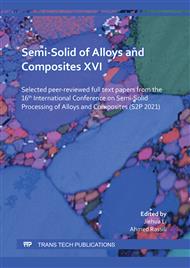[1]
Daquan Li, Fan Zhang, S. P. Midson, Xiaoguang Liang, Hui Yao, Recent Developments of Rheo-Diecast Components for Transportation Markets,, Solid State Phenomena 285, 2019, 417-422.
DOI: 10.4028/www.scientific.net/ssp.285.417
Google Scholar
[2]
Beckmann, R. Grupp, A. Haibel, M. Huppmann, M. Nöthe, A. Pyzalla, W. Reimers, A. Schreyer, R. Zettler, In-Situ synchrotron X-ray microtomography studies of microstructure and damage evolution in engineering materials,, Advanced engineering materials, 9, 2007, 939-950.
DOI: 10.1002/adem.200700254
Google Scholar
[3]
E. Maire, P. J. Withers, Quantitative X-ray tomography,, International Materials Reviews, 59, 2014, 1-4.
Google Scholar
[4]
R. Cepuritis, E. J. Garboczi, S. Jacobsen, Three dimensional shape analysis of concrete aggregates fines produced by VSI crushing,, Powder Technology, 308, 2017, 410-421.
DOI: 10.1016/j.powtec.2016.12.020
Google Scholar
[5]
J. F. Barrett, N. Keat, Artifacts in CT: Recognition and avoidance, RadioGraphics, 24, (2004).
DOI: 10.1148/rg.246045065
Google Scholar
[6]
Gianni Nicoletto, Giancarlo Anzelotti, and Radomila Konečná. X-Ray Computed Tomography vs. Metallography for Pore Sizing and Fatigue of Cast Al-Alloys,, Procedia Engineering 2, no. 1, 2010, 547–54.
DOI: 10.1016/j.proeng.2010.03.059
Google Scholar
[7]
Patrick Hairy, Yves Gaillard, Valeris Buecher & Amaury Chabod, Quantification of Defects in Pressure Die Casting (Part III), 3D Analysis by Tomography", Fonderie et Fondeur d'Aujourd,hui, No. 271, January, 2008, pp.8-22.
Google Scholar
[8]
Andrew Good, Industrial CT at a Glance,, Die Casting Engineer, September 2013, p.40.
Google Scholar
[9]
Alejandro Golob, Quality Control Best Practices: Introducing Industrial CT Scanning into Your Quality Assurance Process,, Die Casting Engineer, May 2015, p.14.
Google Scholar
[10]
Christiane Maierhofer, Philipp Myrach, Mathias Röllig, Florian Jonietz, Bernhard Illerhaus, Dietmar Meinel, Uwe Richter, and Ronald Miksche, Characterization of Pores in High Pressure Die Cast Aluminum Using Active Thermography and Computed Tomography,, 42nd Annual Review of Progress in Quantitative Nondestructive Evaluation, AIP Conf. Proc. 1706, 110009-1–110009-8;.
DOI: 10.1063/1.4940580
Google Scholar
[11]
Itamar Brill, Branden Kappes & Stephen Midson, An Initial Evaluation of CT Scanning for Measuring and Characterizing Porosity in Aluminum Die Castings,, Trans. North American Die Casting 2018 Congress, paper number T18-083.
Google Scholar
[12]
Abdel Rahman Dakak, Valérie Kaftandjian, Philippe Duvauchelle & Patrick Bouvet, Establishment of Acceptance Criteria for Tomography Inspection of Aluminium Alloy Castings,, International Symposium on Digital Industrial Radiology and Computed Tomography, 2 – 4 July 2019 in Fürth, Germany (DIR 2019).
Google Scholar
[13]
Itamar Brill, Dawson Tong, Branden Kappes and Stephen Midson, Using Micro-CT Scanning to Characterize Porosity in Aluminum Die Castings,, Trans. North American Die Casting 2019 Congress, paper number T19-081.
DOI: 10.4028/www.scientific.net/ssp.327.33
Google Scholar
[14]
Danielle M. Barna, Dawson Tong, Branden Kappes, Stephen Midson & Douglas Nychka, Using Sphericity Calculations to Identify the Source of Porosity in Aluminum Castings,, Trans. North American Die Casting 2020 Congress.
Google Scholar
[15]
J. Li, B. Oberdorfer, P. Schumacher, Determining Casting Defects in Thixomolding Mg Casting Part by Computed Tomography, In: M. Tiryakioğlu, W. Griffiths, M. Jolly. (eds) Shape Casting. The Minerals, 2019, Metals & Materials Series. Springer, Cham. https://doi.org/10.1007/978-3-030-06034-3_9.
DOI: 10.1007/978-3-030-06034-3_9
Google Scholar
[16]
J. Li, Bernd Oberdorfer, Daniel Habe, Peter Schumacher,. (2018) Determining casting defects in near-net shape casting aluminum parts by computed tomography,, Frontiers of Mechanical Engineering. 13. , 2018, 1-5. 10.1007/s11465-018-0493-y.
DOI: 10.1007/s11465-018-0493-y
Google Scholar
[17]
L. DeChiffre, S. Carmignato, J.-P. Kruth, R. Schmitt & A. Weckenmann, Industrial Applications of Computed Tomography,, CIRP Annals - Manufacturing Technology, 63, 2004, 655-677.
DOI: 10.1016/j.cirp.2014.05.011
Google Scholar
[18]
Greg Wallace, Andrew P. Jackson, Stephen P. Midson & Qiang Zhu, High-Quality Aluminum Turbocharger Impellers Produced by Thixocasting,, Transactions of Nonferrous Metals Society of China, 20, Issue (9), 2010, 1786-1791.
DOI: 10.1016/s1003-6326(09)60375-7
Google Scholar
[19]
William E. Lorensen, and Harvey E. Cline. Marching Cubes: A High Resolution 3D Surface Construction Algorithm,, SIGGRAPH Comput. Graph. 21, no. 4, August, 1987, 163–69.
DOI: 10.1145/37402.37422
Google Scholar
[20]
Product Design for Die Casting, North American Die Casting publication number 206, (2015).
Google Scholar
[21]
Jessada Wannasin, Marc Fucks, Jiyong Lee, Cheol-Ung Lee, Narasimha Rao & Merton C. Flemings, GISS Technology: Principles and Application in Die Casting,, Solid State Phenomena, 285, 2019, 470-475.
DOI: 10.4028/www.scientific.net/ssp.285.470
Google Scholar
[22]
Thixomolding: What's That?, Design News, April, 2000, available at www.designnews.com/materials-assembly/thixomolding-whats.
Google Scholar


